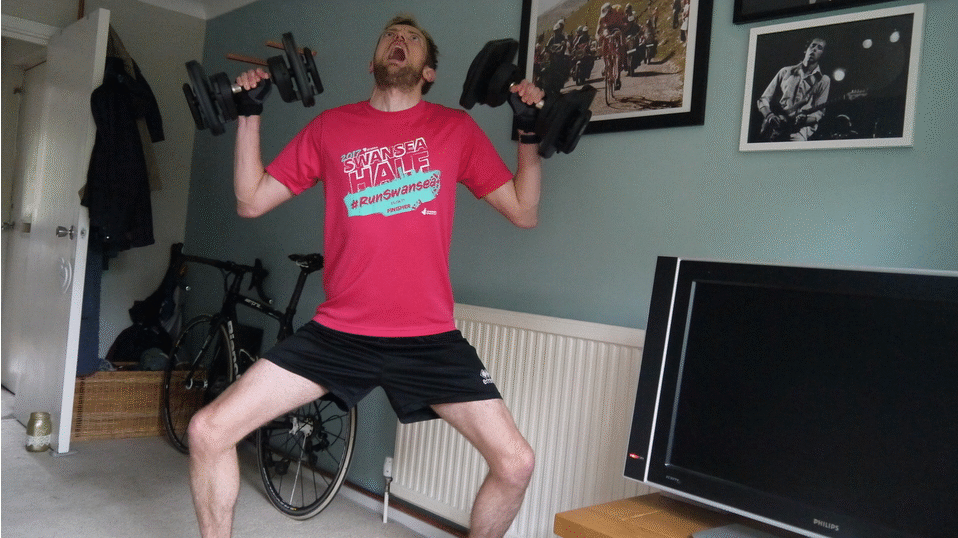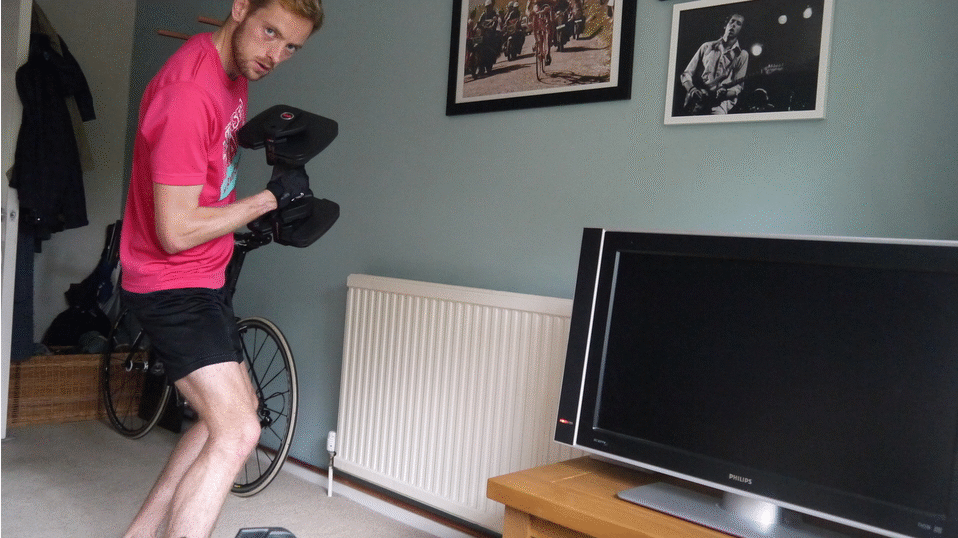Can smart weights replace a dumb personal trainer?
Clever weights? No, there’s a reason they’re called dumbbells

There are some things in life that are supposed to be smart: teachers, phones, me at weddings.
And, proving that life is a wonderful balance, there are some things that shouldn’t be: hairbrushes, me the day after a wedding, sharks.
So when I was told about these smart dumbbells, I didn’t know which camp they should go into. Lifting weights is simple, and I’ve never felt a hankering to chuck a load of tech in there.
But these Bowflex SelectTech 560 weights promised something more: the ability to count my reps for me and at the same time connect to an app to show me what I should be doing.
If that wasn’t enough, they offer adjustable weight with very little space taken up in my tiny flat, so that’s a real win too. Instead of loads of weights on racks, a quick spin of the wrist selects the weight you need in a tiny package.
I was on board. As a runner, I often neglect strength training, but I love technology so much that this was enough to convince me it was time to dust off my weight-lifting gloves and give straining with heavy bits of metal another go, thus improving my running ability due to my soon-to-be lean and lumpy body.
There’s nothing like a set of weights being delivered to your house to tell you that you really need them. The strappingly-stronger-than-me man brought the two boxes in, dumped them in my lounge, and was away.
Get daily insight, inspiration and deals in your inbox
Sign up for breaking news, reviews, opinion, top tech deals, and more.
Then I stupidly moved house, having to lug these weights up and down stairs in tiny pieces because I was too feeble to lift them all at once. And I was still sweating profusely.
But eventually, they were in and I was ready to get going. The ‘smart’ element of the Bowflex SelectTech 560 weights was a sensor attached to one of the weights, with a little LCD display and a large play button.

This contained an accelerometer and Bluetooth connection, which would link with a smartphone or tablet. That meant that I only had one smartbell (as I found myself calling it) and one normal dumbbell. That felt a little rubbish - surely both should be sensor'ed up?
I downloaded the app, nailing the first part of my tech knowledge. Then I found they needed batteries… what is this? Christmas from 1993 when I couldn’t use my remote-controlled car? Why can’t I plug them in?
Anyway, I solved that and was served a video that got me excited once more about the smart abilities of these dumbbells.
The premise was simple: you’re told to start the workout, then the dumbbell calibrates a ‘fitness envelope’ - the path it will take while you’re doing a repetition of the exercise (rep), thus meaning you’ll have to do every single one correctly to achieve a correct rep.

With loads of weight choices on offer, the app being able to know which weight you’re doing when, and smart recording of whatever you’re doing, this was perfect!
No more needing to write down how much I lifted in a small notebook with pencil, desperately trying to work out what I’d scribbled with shaking arms. (Is that… 1kg? 1.5?)
It would all be recorded, my calorie count registered, my progress digitally undeniable. I began to quietly decide which t-shirts would no longer fit my soon-to-be-hulking frame.
I've got to want it
I cranked open the app, choosing what to do. I could get involved with a six week program, just get lifting, or try single workouts. I went for the latter as I couldn't fulfil the full six week program before my deadline (plus I was really tired from moving these weights up loads of stairs).
The first step made sense - I got shown the way to hold the weights to calibrate them, heard three beeps and I was off. This was cool - every lift gave me a little beep, a robotic acknowledgement that I was about to become incredibly beautiful.
But quickly things started to get confusing: the beep to signify the weight was at the right point and the rep completed was changing randomly… sometimes at the start, sometimes in the middle, sometimes at the right point at the top of the lift.
And then random reps were being added in as a result, meaning the exercise was done too quickly. I was torn between being happy that the effort was over (because I had stupidly decided to use more weight than I could handle) and not having actually done what the app had required of me.
I struggled through the rest of the sets, but it was much the same. The exercises where it was a simple up-and-down motion were far more accurate, but anything with crossing over the weights just didn’t want to know about, with random reps being counted for no reason.
(Side note: I've spoken to Nautilus, the brand behind Bowflex, and they think the sensor might be faulty, so I'm going to investigate this. However, the fact it was right some of the time makes me think it's more just the way they work).

Sadly, this followed for the next two days’ worth of efforts - with some more complex exercises just stopping on the app halfway through, presumably exasperated at my sheer inability to lift weights correctly and deciding that it was likely I’d died and these were death throes, not attempts to put on muscle.
That was one of the biggest problems with the app: it didn’t really tell me what to do. There were beautifully fit people showing the rep in a little video, but only from one angle and with no direction on how to lift… I resorted to searching YouTube for a guide.
(I now have multiple search queries in my history along the lines of: ‘What is a deadlift?’, ‘How to deadlift’, ‘How to stop backpain from deadlifts’ and ‘best tips for great baths’)
As a fairly novice weightlifter, I felt like this set-up wasn’t for me. I needed direction… strong warm ups, great tips on how to stretch after to stop the crippling pain and how to decide which weight I should use for each set of reps would be ideal here.
I continued through the week - moving from biceps to shoulders to abs to legs and back again. In terms of creating your own workouts there are so many to choose from, and that’s a real credit.
However, some require extra equipment like a bench, and I kept realising only once I’d started that I couldn’t do that one.
It's all me
Here’s the thing: after a week of using these weights I realised that the idea was excellent. This sensor could provide a perfect record of what you’re doing, offer achievements when you do better, show graphs of progress, suggest weight levels to pick… it could be a digital trainer so easily.
That’s just what I need - something that tells me what to do. I’m a lifting moron, but I want to get better without having to listen to the muscle-bound Petra screaming in my ear about how little I can lift, while paying a huge amount for it.
But with the SelectTech 560 weights, there was just so much wrong. Things like being told I’d burned 2700 calories after 10 minutes of pathetic weight lifting was probably wrong.

Phantom reps showing up didn’t give me confidence that I was doing the motion correctly. My soreness after each day meant I was lifting too much and not cooling down well enough.
So I surmised that these weights weren’t for me, the spaghetti-armed runner. They were clearly for an experienced lifter, or someone less lazy who would do more research on how to lift, and cool down, when you'll obviously need a bench and how to make a proper protein shake.
I was happy with that idea… until I checked out the price. £599 in the UK, $469 in the US (and seemingly not available in Australia) is an eye-watering price. And when you consider non-smart versions of these variable weights are half the price… a seasoned weightlifter would surely just go for them and be happy with a pencil and paper.
So yeah, I’m dumb and these are smart… but not smart enough. Bowflex needs to go back to the drawing board and make an app worthy of the ‘world’s first smart dumbbells’ - they’re just too filled with bugs and lacking in features to be worth the price… but there’s a nugget of an idea here I’m all over.
(Silver lining: I’ve had three lovely baths this week. I’m still in pain, but smell great).
- Gareth Beavis is TechRadar's Running Man of Tech, testing the latest in fitness technology in a never-ending quest to run further and faster and bringing you the results in this column.
- If you want to say hi, he's @superbeav on Twitter
- You can see his stumblings on Strava
- And for more data, follow him on Smashrun
- And if you want to get the full lowdown on the latest and greatest running tech, read the rest of the Running Man of Tech story here

Gareth has been part of the consumer technology world in a career spanning three decades. He started life as a staff writer on the fledgling TechRadar, and has grew with the site (primarily as phones, tablets and wearables editor) until becoming Global Editor in Chief in 2018. Gareth has written over 4,000 articles for TechRadar, has contributed expert insight to a number of other publications, chaired panels on zeitgeist technologies, presented at the Gadget Show Live as well as representing the brand on TV and radio for multiple channels including Sky, BBC, ITV and Al-Jazeera. Passionate about fitness, he can bore anyone rigid about stress management, sleep tracking, heart rate variance as well as bemoaning something about the latest iPhone, Galaxy or OLED TV.